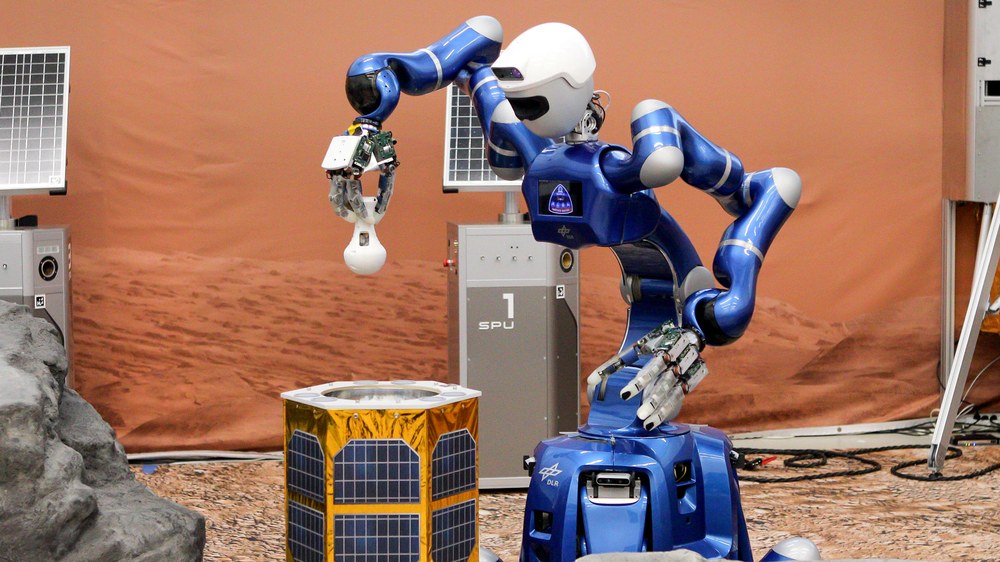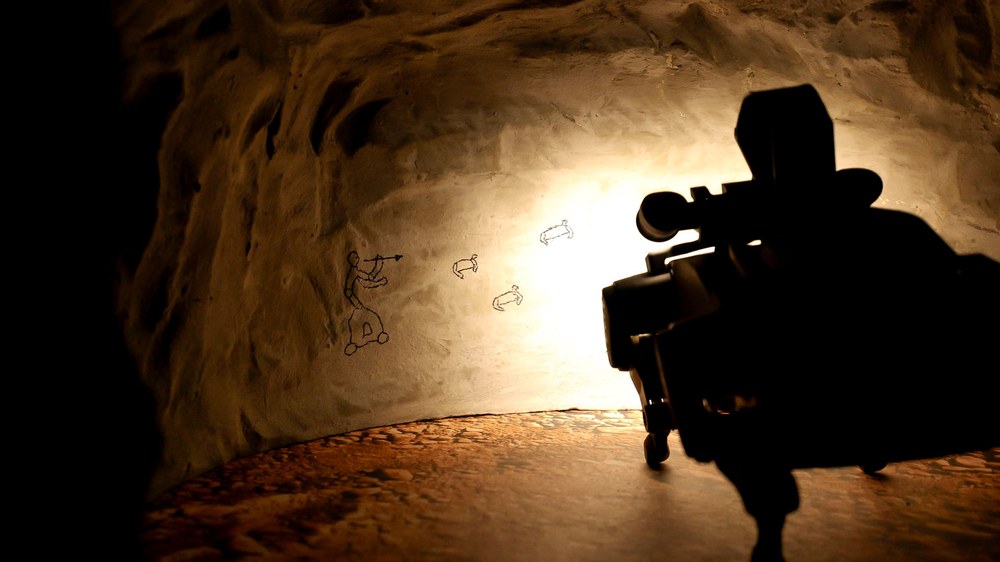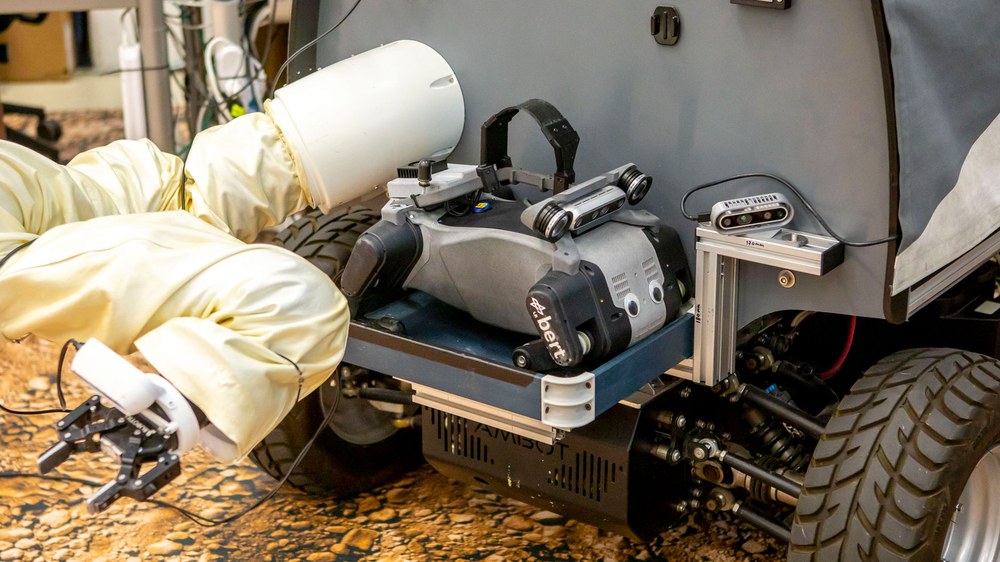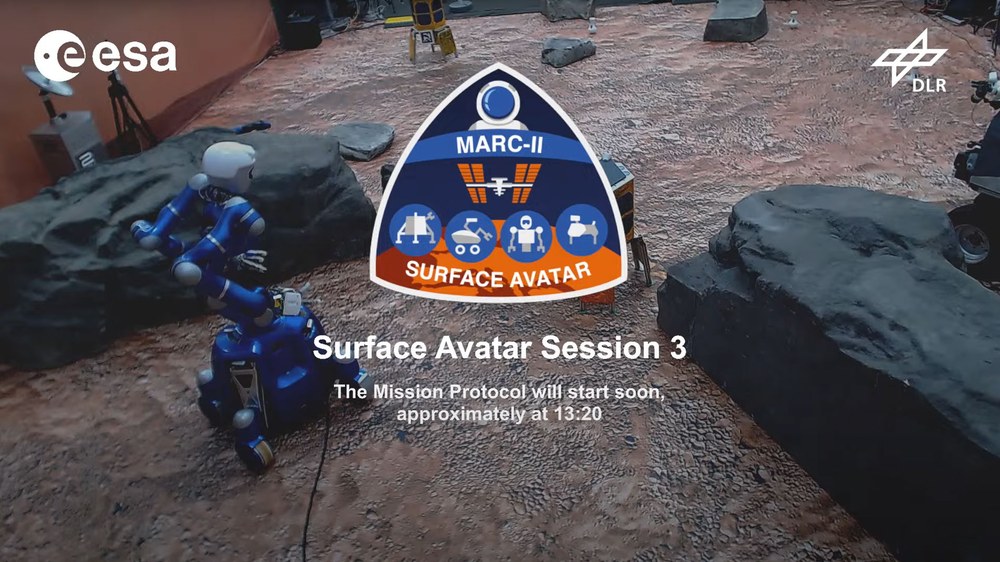Marching towards Mars – ISS robot experiment 'Surface Avatar' successfully concludes



- From the ISS, NASA astronaut Jonny Kim remotely commanded a team of robots on DLR's 'Earthly Mars' site and successfully completed the most challenging experiment in the Surface Avatar series to date.
- Under realistic conditions, the robots demonstrated cooperation and problem-solving skills with the space-bound astronaut – including an induced failure scenario involving an 'injured' four-legged DLR robot, Bert.
- The AI chatbot assistant 'Neal AI', trained by DLR for the experiment, supported the astronaut directly from orbit – a pioneering tool for future space missions.
- Focus: Space, robotics, planetary exploration, ISS, AI
Four robots and a live link to the International Space Station ISS made for an unusual scene at the German Aerospace Center's (Deutsches Zentrum für Luft- und Raumfahrt; DLR) 'Earthly Mars' site in Oberpfaffenhofen. On 24 July 2025, the Surface Avatar team carried out the final and most challenging experiment of the campaign to date. NASA astronaut Jonny Kim, aboard the Space Station, took command of the intelligent robot team on the ground, which helped him safely explore the 'Martian landscape' and collect samples. Jonny could deploy the different robots jointly, semi autonomously or fully autonomously as required. A new feature that was also tested is the AI chatbot assistant 'Neal AI', which provided real-time support for the astronaut's questions.
"Surface Avatar is a milestone in human-robot collaboration in space. We have now achieved all the technical requirements for controlling complex robotic missions on Mars – and for a future permanent lunar research station," explains Alin Albu-Schäffer, Director of the DLR Institute of Robotics and Mechatronics.
The core of the technology demonstration is to enable a person with minimal training to command and deploy a team of varied robots in a targeted manner. The Surface Avatar series of experiments, launched in 2022, is led by the DLR Institute of Robotics and Mechatronics and is being carried out in collaboration with ESA and the German Space Operations Center (GSOC).
"By involving an astronaut in microgravity and using relay satellites, we have overcome the technical hurdles involved in the remote control of robots," says Thomas Krüger, Team Lead of ESA's Human-Robot Interaction Lab. "We are therefore confident that we can manage future scenarios – from the Lunar Gateway and Moon habitats to Earth-robot operations. With these experiments and technologies we have built up unique expertise in Europe, with spin-offs for applications on Earth."
More robots, tougher tasks
Compared with July 2024, not only have the tasks become more difficult and the robots more autonomous, but a fourth robot has also been added. In addition to the humanoid DLR robot Rollin' Justin, ESA's Interact rover and DLR's four-legged Bert, the four-legged ESA robot 'Spot' now completes the exploration team.
Spot is larger than Bert and is equipped with a gripper arm. Astronaut Jonny Kim instructed Spot to autonomously locate sample containers lying around and bring them to the transfer station. The NASA astronaut then moved straight on to DLR's robot Rollin' Justin, whose task was to take the containers from the transfer station to the lander. The two robots autonomously collected several 'Martian samples' for return to Earth, allowing the astronaut to turn his attention to the next tasks.

Livestream: Surface Avatar 3 – ISS-to-Earth telerobotic experiment
Your consent to the storage of data ('cookies') is required for the playback of this video on Youtube.com. You can view and change your current data storage settings at any time under privacy.
Four-legged robot learns to limp
The Surface Avatar team demonstrated the robots' exceptional teamwork and learning abilities in the next challenge – exploring a cave. Jonny Kim commanded the Interact rover, which was carrying DLR's Bert robot in its transport basket – the world's first robot-robot transport. Controlled by the astronaut in space, the Interact rover drove to the cave, carefully lifted Bert with its gripper arm and set the small quadruped down on the ground.
But Bert was 'injured' – one of its legs was jammed, preventing the robot from exploring the cave as planned. The experiment team on Earth had deliberately caused this malfunction so that the astronaut and robot would have to solve an unforeseen problem spontaneously – just like in a real space mission. DLR's Bert robot is equipped with 'reinforcement learning', a method of machine learning. To find a stable gait for Bert with three legs, Jonny Kim conducted a 'training' session: he had the robot try out different gaits and evaluated them until Bert found a functioning three-legged strategy. After the successful training session, the DLR robot carried out its cave exploration. Here, the astronaut opted for manual control – he could see what the robot was seeing through Bert's camera eyes, controlling it remotely using the joystick on the robot command terminal.
AI-assisted preparation
Collaboration between NASA astronaut Jonny Kim on board the Space Station and the robots in the simulated Mars habitat in Oberpfaffenhofen went so well that all tasks – including optional extras – were successfully completed in the short two-and-a-half hour time frame. Kim manually controlled the rover to pick up a sample container and place it in the transfer station. He used the robots to drive around, look about and to explore, touch and feel the surroundings. Kim deployed the robots in an outstanding manner as intelligent co-workers that plan and execute mission tasks on site. They served as a physical extension at a distance – like avatars, in keeping with the spirit of the mission.
To prepare, the astronaut used the new AI chatbot assistant 'Neal AI', which is based on a large language model (LLM) from the European provider Mistral AI. The development team at the DLR Institute of Robotics and Mechatronics trained the chatbot specifically for the Surface Avatar campaign. During the training phase it answered Jonny Kim's questions about the robots' functionalities, the operation of the control unit and the user interface. On future Mars missions, the signal delay between Mars and Earth can be up to 40 minutes. The idea is that during these communication gaps between the exploration team and the control centre, an AI assistant such as Neal AI could immediately help astronauts with any questions they may have.
Cutting-edge robotics from Germany and Europe
"The final Surface Avatar experiment was the perfect conclusion to the mission," summarises Principal Investigator Neal Y. Lii from DLR's Institute of Robotics and Mechatronics. "It demonstrated how robotics can support our astronauts in their exploration of space. I look forward to celebrating further joint successes following this fruitful collaboration with ESA."
To conclude the Surface Avatar series, NASA astronaut Jonny Kim and DLR scientist Neal Lii shook hands – with the help of the DLR robot Rollin' Justin, which used force feedback to convey the force and movement of the handshake to both experiment partners. It was an emotional moment that showcased technology 'made in Germany'. Germany is a global leader in control technology for compensating for time delays in space. This tele-handshake was therefore a fitting tribute to the joint journey of DLR and ESA. Driven by developments in artificial intelligence, robotics will continue to open up new dimensions for humanity.
Related links
- DLR news: Four-legged friends and other robots – ESA astronaut tests avatar control between ISS and Earth
- DLR blog: Surface Avatar – Remotely controlling robots from space to complete tasks and explore other worlds
- About Surface Avatar
- DLR Institute of Robotics and Mechatronics
- DLR site Oberpfaffenhofen
